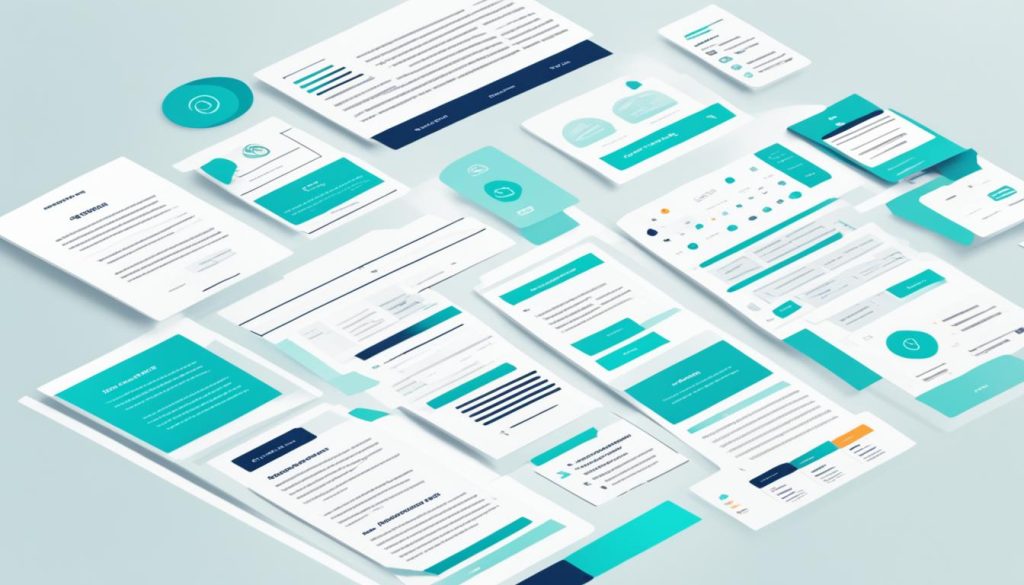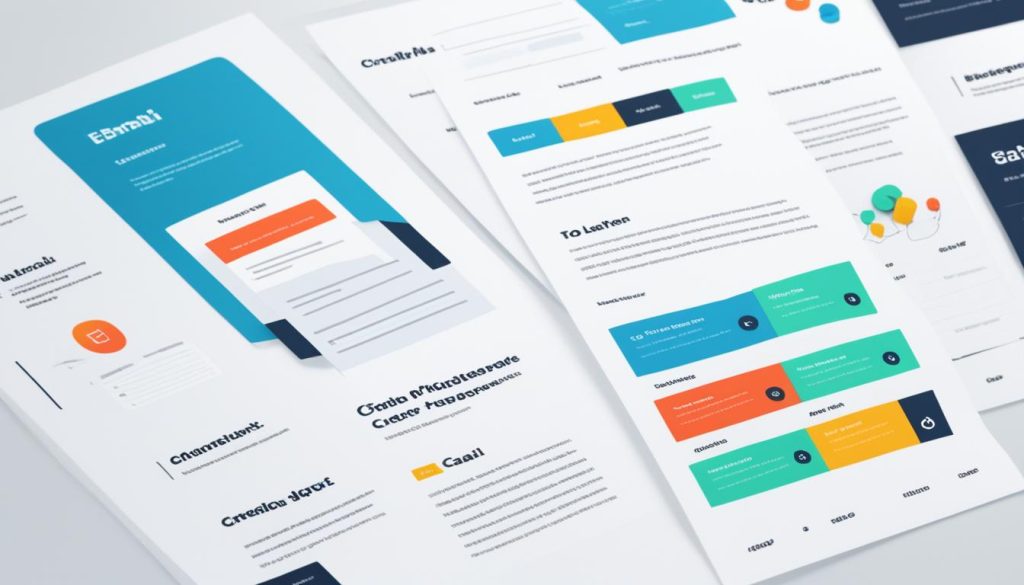Do you feel stuck on making a marketing email that gets attention? Wondering what designs and strategies will make your emails pop?
This article will show you how to create a top-notch marketing email template. You’ll learn the value of good email templates. And find out how to design and use them well. Get ready to make emails that your audience will love.
Are you set to boost your email marketing and see amazing results? Let’s jump in and uncover easy ways to make a great marketing email template!
How to Make a Marketing Email Template
- Learn why email templates are crucial for successful email marketing campaigns.
- Understand the key elements that should be included in your email template.
- Discover 12 design tips to make your email template visually appealing and engaging.
- Explore the options provided by platforms like Mailchimp and Outcomes for creating email templates.
- Consider the benefits of working with virtual assistants to streamline the email template creation process.
Why You Should Consider an Email Template Design
Email templates bring lots of benefits to email marketing campaigns. They save time and give your emails a uniform look. This consistency is key for any business looking to enhance their emails.
Time-Saving Email Templates
Building emails from the ground up is hard and takes forever. Email templates can change that. They have a ready-made layout. This means you can spend more time on your message instead of its look. Quickly craft emails that grab your audience’s attention with these templates.
Benefits of Email Templates
Email templates boost your marketing in many ways. They make sure your emails match your brand perfectly. Your emails will always look professional, helping your brand stay in people’s minds.
These templates work well on phones, computers, and tablets. More people read emails on their phones now. So, having a template that looks good everywhere is important. It makes sure everyone has a good experience with your emails.
Consistent Branding with Email Templates
Email templates help keep your brand’s look the same in all your emails. They show your logo, colors, and fonts consistently. This makes your brand easy to recognize and remember.
They also make testing easier. No need to mess with sizes or layouts for different devices. The templates are made to work everywhere. This keeps your emails looking great, no matter what.
Using email templates saves you time, keeps your brand consistent, and makes sure emails look good on all devices. They help your email marketing work better. This means better results for your business.


Things to Consider Before Designing an Email Template
Before you start designing an email template, there are some important things to think about. These points will help make sure your template sends your message well and connects with your audience. Here’s what you should consider:
Purpose of the Email
First, figure out what your email aims to achieve. Are you sharing information through a newsletter or promoting a sale? The goal of your email will affect its design and layout. It will guide you, whether you’re catching attention with an offer or sharing useful content.
Brand Style Guide
Keeping a consistent brand identity is crucial. Your email template should match your brand’s style guide. Use the right colors, fonts, and images that show what your brand is about. A consistent design boosts brand recognition, trust, and credibility with your audience.
Target Audience for Email Template
Knowing who your email is for is key to a great design. Think about their likes, the way they communicate, and what they want to know. Design your template to meet their needs and expectations. Personalizing emails for your audience boosts engagement and results.
Keep these points in mind, and you can create an email template that delivers your message well. It will support your brand and connect with your audience.
4 Key Elements Your Email Template Should Include
When creating an email template, make sure to include four key elements. These are the header, body, call-to-action button, and company info. They help ensure your email is effective and successful.
Header
The first thing people see when they open your email is the header. It introduces your email’s content and sets the tone. Include your company logo, a catchy headline, or a personal greeting.
A well-designed header grabs attention and makes a good first impression. This makes the email more engaging.
Body
The body contains your main message. It should be clear, brief, and look good. Use short paragraphs, bullet points, or headings to organize it.
Add relevant images or videos to make your email more visually attractive. This helps get your message across.
Call-to-Action Button
A call-to-action (CTA) button is vital. It encourages people to take an action, like buying something or subscribing. Make your CTA button stand out with different colors, bold fonts, and persuasive text.
Company Information
Don’t forget to include your company info. Put this in the footer or email signature. Add your logo, contact details, social media links, and any legal disclaimers.
This information makes it easy for people to contact you. It also makes your email more credible.


Including these four elements in your email template makes it effective and engaging. You’ll be able to clearly communicate your message and encourage action. Now, let’s look at 12 design tips to make your email template visually appealing.
7 Design Tips for Your Email Template
Creating an engaging email template is crucial. There are key design tips that can help a lot. By using these tips, your emails will have more impact, encouraging people to act. Here are 7 tips to improve your email’s design.
- Design Hierarchy in Emails: Place important info at the top with headings and bullet points. It guides the reader and highlights key messages.
- Simplicity in Email Design: Keep your template simple and uncluttered. Use clear headlines and concise content to get your message across without overwhelming readers.
- Mobile-Friendly Email Design: Many people read emails on their phones, so make your design mobile-friendly. Use responsive design to make it easy to read and navigate on small screens.
- Eye-Catching Imagery: Use compelling images to break up long text sections. Choose high-quality visuals to grab attention and improve your email’s look.
- Effective Use of Color and Fonts: Pick colors and fonts that reflect your brand and look good. Use contrasting colors for interest and readability. Choose fonts that are clear on all devices.
- Negative Space in Email Design: Use negative space, or white space, for a clean layout. It focuses attention on key parts and makes it easier to read.
- Clear Call-to-Actions: Make your calls-to-action bold and simple. Use direct language. Position them to make readers want to act.


Following these tips will help you create a standout email template. It will catch the eye, communicate well, and prompt action. Always test your template on various devices and email clients for the best results.
Creating an Email Template with Mailchimp
Mailchimp is a top pick for designing eye-catching email templates. Its email builder is easy to use, offering many design options. This makes creating templates simple.
You can start with a ready-made template or build one from scratch. Mailchimp’s email builder lets you design responsive templates. These work well on both computers and phones.
Mailchimp’s pre-built templates offer many professional designs. They’re suited for various industries and goals. These templates are a good starting point and can be customized to fit your brand.
If you want full control over your email design, Mailchimp has what you need. Their drag-and-drop editor lets you arrange content blocks, images, text, and buttons. This way, you can create a template that truly represents your brand.
Mailchimp’s email builder has a great preview and testing feature. Before you send emails, you can see how they’ll look on different devices. This ensures your design is consistent and appealing everywhere.
Mailchimp also offers a Form Builder for custom signup forms. This tool helps you gather important info from your audience. You can then engage them with personalized content.
Overall, Mailchimp’s email builder makes template creation easy. You can choose from pre-built templates or customize your own. Mailchimp provides all you need for impactful, good-looking emails.
| Pros of Using Mailchimp for Email Template Creation | Cons of Using Mailchimp for Email Template Creation |
|---|---|
| 1. User-friendly email builder | 1. Limited customization options for pre-built templates |
| 2. Responsive templates for desktop and mobile | 2. Limited design flexibility for custom templates |
| 3. Pre-built templates for various industries and purposes | 3. Learning curve for beginners |
| 4. Drag-and-drop editor for custom designs | 4. Advanced features may require a paid subscription |
| 5. Preview and testing features for different devices | 5. Limited customization options for signup forms |
Mailchimp is a popular tool for making email templates, thanks to its user-friendly setup. It offers responsive design options and customizable features. Mailchimp’s email builder is great for both beginners and experienced marketers looking to create effective, visually engaging emails.
Creating an Email Template with Outcomes
Outcomes makes it easy to create email templates for different needs. It offers two types: system email templates and marketing email templates. Both types let you customize your emails exactly how you want them.
System Email Templates:
System email templates are perfect for transactional emails. These are important for sending basic notifications. Using them means you can quickly share vital info with people.
Marketing Email Templates:
Marketing email templates, however, are for making your emails look great and grab attention. You can use these to share more info, promote things, or connect with customers. They help tie your emails into your marketing strategy.
With Outcomes, customizing your marketing emails is easy. You can add merge fields to make each email feel personal. This approach makes your emails more relevant to each person who gets them.
Also, Outcomes ensures your emails look good on any device. This is important because a lot of people check emails on their phones or tablets. So, your emails will always look their best, no matter where they’re seen.
Outcomes gives you everything you need to make amazing email templates. Whether for basic notifications or detailed marketing, you’re all set. Outcomes supports both these needs perfectly.
Now, let’s dive deeper into how you can fully utilize what Outcomes offers for your emails.
Working with Virtual Assistants for Email Template Creation
Creating email templates can take a lot of time. This is true if you’re handling several campaigns or have few design resources. Luckily, virtual assistants can make this easier. They help ensure your emails look professional. They help from starting to finish. This includes gathering requirements, choosing templates, editing, applying brand styles, and testing.
When you start with a virtual assistant, it’s vital to be clear about what you need. Share details about your goals, who you’re trying to reach, and any branding rules. This way, your template will match your vision and deliver your message effectively.
Virtual assistants can help you pick a pre-made template or make a new one from scratch. They have access to a lot of professional designs. These can be customized to fit your brand and goals.
After picking or making a template, virtual assistants add and edit parts like text, pictures, and buttons. This makes sure your content looks good and grabs attention. They also use your brand’s styles, such as colors, fonts, and pictures. This keeps your look consistent.
Testing your template is very important. Virtual assistants make sure your template works well on all devices and email platforms. They can also plan when to send out your emails.
It’s also crucial to check how well your emails are doing. Virtual assistants watch things like how many people open your emails, click links, and take action. This info helps you make better decisions and improve your next campaigns.
In the end, virtual assistants document everything that was done in creating the template. This includes any changes or design choices. This record is helpful for your future campaigns. It helps keep your email marketing consistent.
Working with virtual assistants for email template creation saves you time. It makes sure your designs are professional. Plus, it helps make your email campaigns better overall.
Next, let’s see how to use platforms like Mailchimp and Outcomes for making email templates.
| Virtual Assistant Tasks for Email Template Creation |
|---|
| Gathering requirements and specifications for the template |
| Selecting or creating templates |
| Adding and editing elements like text, images, and buttons |
| Applying brand styles to maintain visual consistency |
| Testing the template across devices |
| Scheduling the template for deployment |
| Monitoring performance metrics |
| Providing documentation for future reference |
Conclusion
Creating email templates is key to a successful email marketing campaign. Follow the steps in this article for a professional, engaging email template. This will help you to effectively share your message with your audience. Think about your design’s layout, keeping it simple and mobile-friendly.
Use striking images, colors, and fonts to make your emails stand out. Remember to add clear call-to-action buttons and your company’s info. This makes for a seamless experience and keeps your brand consistent. Tools like Mailchimp and Outcomes make creating email templates easier.
Considering virtual assistants can help streamline making email templates. They handle tasks from gathering requirements to scheduling emails. They ensure brand styles are applied, emails are tested, and performance is monitored. Virtual assistants help you get better results and save time.
Following best practices and using available tools and resources leads to effective email templates. These engage your audience and boost your email marketing campaign’s success. Start creating your email templates now and see the difference it makes in your business.


